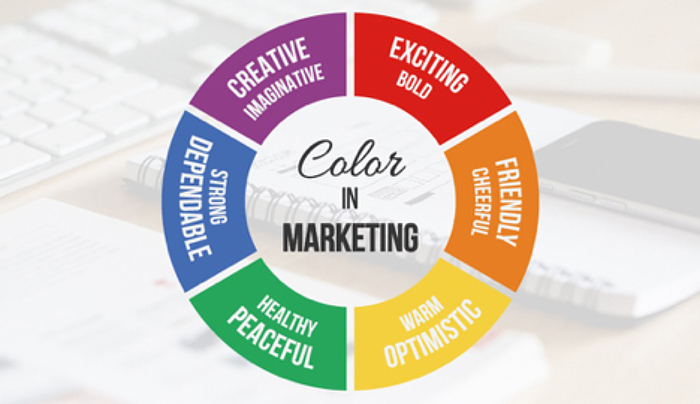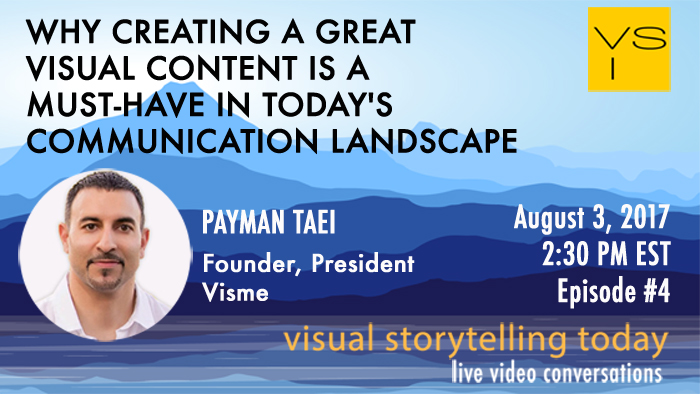July 28, 2017
Why Creating a Great Visual Content is a Must-Have in Today’s Communication Landscape
Marketing is about Telling Stories where Your Customer Plays the Hero and Your Product – the Magic Wand
Even though you might not realize it, marketing is really just another communication medium. You’re taking thoughts and ideas and presenting them to people in a form that is easy to digest and to support.
It’s really not all that different from something like a feature film when you really think about it, only instead of telling the story of “boy meets girl, they fall in love and get married” what you’re really telling is the story of “here is why this particular product or service is going to change your life.”

As is true with any communication medium, the way in which a message is perceived often affects its ultimate impact. You could have an objectively good idea on your hands, but if you present it in the wrong way you’re going to do a lot more harm than good.
These ideas are ultimately why great visual content is so important, especially in an era dominated by digital technology and social media networks. Visual content isn’t just about pretty pictures – it’s about a better, more natural, more effective way to communicate with the widest possible audience.
Make no mistake: creating visual content is ESSENTIAL in today’s communication landscape for a number of compelling reasons that are more than worth exploring.
It’s About Supporting the Way the Mind Works
Part of the reason why visual content is so powerful in the first place ultimately comes down to the way the human brain actually operates. Keep in mind that in a given day, 90% of all information sent to the brain by your senses in visual nature. This goes a long way towards explaining why according to most studies, 65% of people are visual learners. They simply understand and retain more when it’s taken in visually versus what they read or hear.

A number of studies have been done over the years that support the idea that visuals are one of the most effective methods of communication that we have. Consider the fact that the human brain can interpret images in just 13 miliseconds, or that people following directions with text AND illustrations do 323% better than people just trying to follow along with text.
We’ve always been visual learners – it’s an idea as old as the human race itself. The Internet and marketing in general are only finally starting to catch up with what we’ve always known. What is marketing if not an effort to get someone to follow directions, meaning that you’re trying to entice someone to make a purchase or take a particular step?
If the people do far better at following directions with images than they do with just text alone, it stands to reason that this is something you would want to get behind.
Visual Communication Gives You More Control Over Your Message
Visual communication is also inherently more powerful than traditional text because it gives you a far greater level of control over what matters most of all: your message.
Consider the example of a video (in this case from my video series), when you take an idea and present it in the form of a 1000 word blog post, there are a lot of factors you can’t control. You can’t control how people are perceiving certain ideas. You can’t predict how they’re going to emphasize certain words for maximum impact. You can’t control how fast they read. All of these could potentially dilute your message.

When you take that same message and present it in the form of a video created with a tool like Visme, on the other hand, suddenly you eliminate all of these X factors. A narrator can emphasize certain words for impact. Compelling visuals can keep someone watching. You can control pace, which you can control the rate at which ideas are conveyed to keep people from getting too overwhelmed (or again, to underline a particularly important point).
It’s the Direction We’re Headed In
Statistics like these also go a long way towards explaining the direction that marketing and the Internet in general is already headed in. One study estimates that people tend to form a first impression in a mere 50 milliseconds – because the brain processes visuals much faster than it does simple text, it stands to reason that a visual first impression will almost always be more powerful than a block of words that you hope someone reads.
Likewise, the vast majority of all people already just skim the content they read online. Most people don’t make it past the headline and when you get past the first paragraph of something, those numbers start to drop off very quickly. According to some studies, it takes just eight seconds for someone to get distracted – though others have that number as low as 2.8 seconds.
For marketers, it’s true that these are all challenges – but they’re ones that great visual content helps to solve essentially all at the same time. Remember that by as soon as 2018, an estimated 84% of all communications will be visual according to Inc.com. They also predict that 79% of ALL Internet traffic will be video content by about the same period of time.
Visual content is a necessity in today’s communicate landscape because it checks a lot of boxes in one fell swoop. It’s instantly attention grabbing, compelling and engaging. It translates a message into a medium that the brain is already receptive to and it’s one that people have already said that they want more of.

If you’re looking at a tool that promises all of this and more, it would be a huge mistake not to take full advantage of it. Yet that’s exactly what you’re doing by failing to incorporate high quality visual content into your campaigns.
Want to know more?
Join me on August 3rd @ 2:30PM ET on Visual Storytelling Today live video show. I’ll be talking more about why visual content is a must-have in today’s communication landscape, including sharing an effective end-to-end process, examples, and actionable tips you can apply to your business.
Register FREE here.
Already have questions you want me to address? Sweet! Tweet your questions using: #myVSI
Source: Visual Storytelling
July 28, 2017
The A.V. Club
IMAX is officially going to start pulling back on 3-D releases, so we can all stop having to make sure we’re buying tickets for the 2-D screening.
Source: CW’s Flipboard Feed
July 28, 2017
2018 SXSW Registration & Housing Opens Tuesday, August 1

Mark your calendars – SXSW 2018 is open for business on Tuesday, August 1!
Join us for the 2018 SXSW Conferences & Festivals from March 9-18 for an event packed full of showcases, screenings, conference sessions, exhibitions, tacos (so many tacos), workshops, networking events, mentor sessions, unexpected discoveries, and so much more.
Save big when you register early for SXSW 2018 and get the most hotel options. With expanded access to events for all registrants, attendees will receive primary access to programming associated with their badge type but now also enjoy secondary entry to most other SXSW events.
Find out which badge is the perfect fit for you – registration rates and badge information are available now. After you register, make hotel reservations through SXSW Housing & Travel. Rooms during March go quickly, so on Tuesday, August 1 be sure to check the Availability page and enter your dates to see all available hotels, room types, rates, and amenities.
Recently Announced 2018 Programming
Earlier than ever before, we have already revealed the first SXSW Conference announcement of the season including three Keynotes and five Featured Speakers. Keynotes announced include Academy Award-winning writer and director Barry Jenkins (Moonlight, Medicine for Melancholy), psychotherapist and best-selling author Esther Perel, and technology entrepreneur and quantum computing expert whurley. Featured Speakers announced include space entrepreneur and futurist Bob Richards, Kaiser Permanente chairman and CEO Bernard J. Tyson, Empowering a Billion Women by 2020 chairman and CEO Ingrid Vanderveldt, artist and poet Cleo Wade, and author and founder of the Future Today Institute Amy Webb.
Stay tuned to SXSW News for many, more announcements, programming updates, applications, awards, and beyond throughout the 2018 season.
Apply to Participate
Learn how to participate in one of the many prestigious SXSW categories including SXSW Film Festival submissions, SXSW Music Festival Showcasing Artist applications, Interactive Innovation Awards, SXSW Accelerator Pitch Event, David Carr Prize, SXSW Art Program, and SXSW Community Service Awards. Then help shape the March event during PanelPicker Community Voting from Monday, August 7 – Friday, August 25.
Join Us for SXSW 2018
On Tuesday, August 1, register to attend and book your hotel to begin your SXSW adventure! Get ready to help us write the next chapter of SXSW during March 9-18, 2018.
Sign up for SXSW Event Updates and follow us on Twitter, Facebook, and Instagram.
SXSW Conference & Festivals – Photo by Carol Watson
The post 2018 SXSW Registration & Housing Opens Tuesday, August 1 appeared first on SXSW.
Source: SxSW Film
July 28, 2017
SXSW Film Festival Headliner Atomic Blonde in Theaters Now [Video]
“This was really a job that was a bit of a dream come true, I developed this five years ago from very, very little. You never know the journey of a film, and to be here today, and to have the film that we have, and how incredibly proud we are of it, and how it turned out, happens very rarely, ” – Atomic Blonde Cast Member, Charlize Theron.
Much like Baby Driver and The Disaster Artist, SXSW audiences were exhilarated at the world premiere of Atomic Blonde at the SXSW Film Festival in March, seeing for the first time director David Leitch’s action packed cold-war thriller, starring Theron and James McAvoy, equal parts spycraft, sensuality and savagery. Check out the SXSW Q&A and get to a theatre for this exciting film!
Leitch is an actor, writer, producer, stunt coordinator, and film director. He made his directorial debut in 2014 with John Wick, co-directed by Chad Stahelski. He begins production on the highly anticipated Deadpool 2 this summer.
Learn More About SXSW 2018
Learn how to successfully enter your film to the 2018 SXSW Film Festival with our How to Submit Your Film video and find out more information about deadlines and fees here.
Mark your calendars for Tuesday, August 1 when registration, housing, and press accreditation opens for the 2018 SXSW season. We hope to see you in March!
Follow us on Facebook, Twitter, Instagram, and SXSW News for the latest SXSW coverage, announcements, application tips, and updates.
Photo by Matt Winkelmeyer/Getty Images for SXSW
The post SXSW Film Festival Headliner Atomic Blonde in Theaters Now [Video] appeared first on SXSW.
Source: SxSW Film
July 24, 2017
2018 SXSW Art Program Applications Now Open

SXSW is awaiting your project ideas for the 2018 SXSW Art Program. Showcase your experiential and visual artwork to spark discovery, inspiration and connection at SXSW 2018. The program offers a great opportunity for your creative work to gain exposure to new audiences in the fields of music, film, and technology. Enter your idea before the final deadline on Friday, September 8, 2017.
The art program highlights emerging and established artists, and serves as a launching point for collaborations and discussions around the role of visual and digital media arts in culture and technology. The inaugural art program was held at SXSW 2017.
All visual artists – studios, designers, collectives, and individual artists – are eligible to enter their project. Once we have collected all proposals, final selections will be made by the SXSW Art Team with proposal feedback from our Advisory Board members. Look over the art application details to learn more about proposing an idea for the 2018 SXSW Art Program.
Don’t miss out on the chance to participate in the innovative and inspirational environment at SXSW 2018 by having your work showcased in front of thousands of creatives, global professionals, industry leaders, and more. Enter now before Friday, September 8, 2017 at 11:59pm PT.
2017 SXSW Art Installation, toki – series #02 by Akinori Goto – Photo by Chris Smith
The post 2018 SXSW Art Program Applications Now Open appeared first on SXSW.
Source: SxSW Film
July 24, 2017
Barry Jenkins, Esther Perel, and whurley Announced as 2018 SXSW Keynotes, Plus Featured Speakers

We are kicking off the 2018 season early with the reveal of select Keynotes and Featured Speakers for the SXSW Conference. SXSW spotlights some of the industry’s most inspired thinkers, diverse visionaries, and change-makers who share forward-thinking ideas. We are thrilled to share with you our first announcement featuring some of the biggest and brightest names of our time.
Keynotes announced today include Academy Award-winning writer and director Barry Jenkins (Moonlight, Medicine for Melancholy), psychotherapist and best-selling author Esther Perel, and technology entrepreneur and quantum computing expert whurley. Featured Speakers announced today include space entrepreneur and futurist Bob Richards, Kaiser Permanente chairman and CEO Bernard J. Tyson, Empowering a Billion Women by 2020 chairman and CEO Ingrid Vanderveldt, artist and poet Cleo Wade, and author and founder of the Future Today Institute Amy Webb.
“We are overjoyed to invite Barry Jenkins back to SXSW as a Film Keynote having presented the world premiere of his first feature, Medicine for Melancholy, in 2008,” said Janet Pierson, Director of Film. “Moonlight is a magnificent piece of work, transcendent, and made on his own terms. We couldn’t be happier for his success and to have this remarkable artist with such a generous soul return to SXSW.”
Beginning Tuesday, August 1, register to attend SXSW and explore what’s next in the worlds of entertainment, culture, and technology during the 2018 SXSW Conference & Festivals from March 9-18 in Austin, TX.
“SXSW has become a premier destination for innovation and creative discovery. We’re pleased to begin our 2018 season with strong programming that represents a diverse and talented group of pioneers in the technology, social sciences, and entertainment industries,” said Hugh Forrest, Chief Programming Officer. “To be able to announce such a strong lineup before registration opens is an excellent indicator that this is going to be one of our best years ever.”
Read more about our first installment of speakers for the 2018 SXSW Conference below. We cannot wait to see what these industry leaders and visionaries share with SXSW attendees.
Keynotes
Barry Jenkins (Film Keynote) – Academy Award winner Barry Jenkins feature film debut, Medicine for Melancholy (which had its world premiere at SXSW in 2008) was hailed as one of the best films of 2009 by The New York Times. Jenkins received an Academy Award for Best Adapted Screenplay for his second feature Moonlight, which won Best Picture at both the Oscars and the Golden Globes (Drama). His upcoming projects include adaptations of If Beale Street Could Talk and The Underground Railroad.
Esther Perel (Interactive Keynote) – Psychotherapist Esther Perel is recognized as one of today’s most insightful and original voices on modern love. Fluent in nine languages, she holds a therapy practice in New York City and serves as an organizational consultant for Fortune 500 companies around the world. Her celebrated TED talks have garnered more than 18 million views and her bestseller Mating in Captivity: Unlocking Erotic Intelligence became a global phenomenon translated into 24 languages. Her recent book, The State of Affairs: Rethinking Infidelity, is another example of her bold synthesis of complex cultural shifts.
whurley (Convergence Keynote) – whurley is a Managing Director at Goldman Sachs and the founder of Honest Dollar, a fintech company Goldman purchased in 2016. He is the Chair of the Quantum Standards Working Group at the Institute of Electrical and Electronics Engineers (IEEE). His latest book Endless Impossibilities brings the realities of a quantum future into the present, helping readers understand and prepare for the coming age of quantum computing.
Featured Speakers
Bob Richards (Intelligent Future) – Bob Richards is a space entrepreneur and futurist. He is a Co-Founder of the International Space University, Singularity University, SEDS, the Space Generation Foundation, and Moon Express, Inc., a space transportation and lunar resources company located at Cape Canaveral, where he currently serves as President and CEO.
Bernard J. Tyson (Health & Wellness) – Bernard J. Tyson is the chairman and CEO of Kaiser Foundation Health Plan, Inc. and Hospitals — known as Kaiser Permanente, one of America’s leading integrated health care providers and not-for-profit health plans. Under Tyson’s leadership, Kaiser Permanente continues to focus on providing affordable, accessible, high-quality health care and improving the health of its members and communities.
Ingrid Vanderveldt (Startup & Tech Sectors) – Ingrid Vanderveldt is the Chairman and CEO of Empowering a Billion Women by 2020 (EBW2020). Previously, she was the first Entrepreneur-in-Residence (“EIR”) for Dell Inc. where she oversaw entrepreneurial initiatives worldwide helping to build a $250 million business segment and founded the $125M Dell Innovators Credit Fund, Dell Founders Club, and the Dell Center for Entrepreneurs during her 3-year term.
Cleo Wade (Social Impact) – Cleo Wade, an outspoken artist, speaker, poet, and the author of a forthcoming book, is an inspiring voice in today’s world for gender and race equality. She creates motivating messages, blending simplicity with positivity, femininity and arresting honesty. Her poems, accessible yet empowering, speak to a greater future for all women, people of color, and the LGBTQ community, preaching love, acceptance, justice, and peace.
Amy Webb (Startup & Tech Sectors) – Amy Webb is an author, futurist and Founder of the Future Today Institute, a strategic foresight and futures forecasting company that advises the world’s leading businesses and governments. Forbes named Amy one of the world’s preeminent thinkers on the future impacts of technology.
Join Us at SXSW 2018
Registering for SXSW is the only way to experience these fantastic speaker sessions. Mark your calendars for Tuesday, August 1 when registration and housing opens for the 2018 SXSW Conference & Festivals in Austin, Texas from March 9-18. With expanded access to events for all registrants, attendees will receive primary access to programming associated with their badge type but now also enjoy secondary entry to most other SXSW events. Start planning today by browsing badge types to find the perfect badge for you.
Learn how to participate in one of the many prestigious SXSW categories including SXSW Film Festival submissions, SXSW Music Festival Showcasing Artist applications, Interactive Innovation Awards, SXSW Accelerator Pitch Event, David Carr Prize, and the SXSW Art Program. Then help shape the March event during PanelPicker Community Voting from Monday, August 7 – Friday, August 25.
We have only just begun – stay tuned for many, more big announcements, programming updates, applications, awards, and beyond throughout the season. Sign up for SXSW Event Updates and follow us on Twitter, Facebook, and Instagram.
2018 SXSW Keynotes (l-r): Berry Jenkins – Photo by courtesy of the speaker; Esther Perel – Photo by Karen Harms; and whurley – Photo courtesy of the speaker.
The post Barry Jenkins, Esther Perel, and whurley Announced as 2018 SXSW Keynotes, Plus Featured Speakers appeared first on SXSW.
Source: SxSW Film
July 24, 2017
How to Overcome Stress with Visual Storytelling
We all carry worries and anxieties about future events that could go wrong in our lives. When you really unpack what exactly is this worry or stress your mind is producing, you find a simple truth.
Stress or worry is in essence, a story we tell ourselves with a bad ending. It’s an imagined outcome that has never happened yet and may never will. These negative stories tend to pop up deep in the night when your storytelling mind is wandering with a wide range of dramatic narratives, chasing away your sleep.
It’s an old survival mechanism we’ve been using for eons. Most likely since the first cave man tossed and turned all night, worrying that there are no wandering bears outside his cave.
Then you wake up in the morning, upbeat for a new day – and those wild stories are replaced with hopeful thoughts (translation: the same horror stories from last night where you just edited the ending to a more positive resolution) – and go happily with your day.
From this perspective, your storytelling mind is like a big data story trafficking engine that based on a wide range of variables; past experiences, hopes, and beliefs (even time of day) – is constantly churning out stories to make sense of and respond to the world around you. And you get to play, pause, rewind or fast-forward these visual stories in your mind.
If you’re thinking a Demand-Side Platform (DSP) from the digital advertising world, you’re not far off. Just replace the ads with stories and you get a Demand-Story Platform.
The difference is that only you manage the story inventory and the Real-Time Bidding (RTB) for a convincing story.
When your mind is seeking to find a meaning to an event, it will demand a convincing visual story to rationalize it and a proper call-to-action.
As I mentioned in a recent post since we are constant seekers of meanings, “we’re all players in our own movies where we play the hero, the director, the cameraman and most importantly the editor“ – then we edit what we see in order to create meanings. Such editing work could play with the narrative timeline back and forth until landing on a story we find personally meaningful.
Now that you understand how stress works – at least from a storytelling perspective – and why the editing principle is so powerful, try to distribute positive visual narratives in your campaigns.
These vivid stories will empower your audience and their minds to picture a great outcome to a burning problem they’re facing. What’s more, your solution could be that key to transforming their stress into an opportunity.
In short, your story will become THEIR STORY!
Let me know how this strategy is working for you. If you’d like to chat, I’d be happy to exchange ideas.
Source: Visual Storytelling
July 23, 2017
Dunkirk Veteran on Christopher Nolan’s World War II Drama: ‘It Was Just Like I Was There Again’
With a 94 on Metacritic and a $50 million debut at the box office, Dunkirk is already one of Christopher Nolan’s most well-received films. It isn’t just critics and fanboys who appreciate his tense new World War II drama, however, as at least one veteran of the battle itself is now signing its praises as well: “I never thought I would see that again,” said 97-year-old Ken Sturdy. “It was just like I was there again.”
“It didn’t have a lot of dialogue. It didn’t need any of the dialogue because it told the story visually and it was so real,” he continued. “Dunkirk” is light on conventional plotting and dialogue, as Nolan opted for an experiential, you-are-there approach that favors action over words. Study, who was 20 at the time, served as a signalman in the Royal Navy and helped soldiers evacuate the beach where 68,000 British soldiers were captured or killed and more than 300,000 were eventually rescued.
“I had the privilege of seeing that film tonight and I am saddened by it because of what happened on that beach,” he said. “I was 20 when that happened, but watching the movie, I could see my old friends again and a lot of them died later in the war. I went on convoys after that in the North Atlantic. I had lost so many of my buddies.” Learn more about Sturdy here.
Stay on top of the latest breaking film and TV news! Sign up for our Email Newsletters here.
Source: IndieWire film
July 23, 2017
‘Captain Marvel’ Concept Art Shows Brie Larson Fighting the Skrulls — in the 1990s
When it hits theaters in 2019, “Captain Marvel” will become the first Marvel movie centered around a female superhero. Brie Larson has the distinction of leading the upcoming film, which was teased at Comic-Con with new concept art yesterday — as well as the revelation that it will take place in the ‘90s, well before any other chapter in the ongoing Marvel mythos.
It will also pit Captain Marvel (aka Carol Danvers) against the Skrulls, a race of extraterrestrial shapeshifters most familiar to comic-book fans for their appearances opposite the Fantastic Four. Helping the superheroine in that task will be Nick Fury (Samuel L. Jackson), who at this point will still have the use of both eyes — and thus no need for his signature eyepatch.
Marvel Studios’ Kevin Feige told Variety last year that Captain Marvel is one of the most powerful heroes in that particular cinematic universe: “If you had the collector cards of the Marvel characters and you could see the power levels, she would be off the charts compared to anyone that we’ve previously introduced in a film.”
“Captain Marvel” is slated to arrive in theaters on March 8, 2019 and will be directed by Anna Boden and Ryan Fleck. Avail yourself of the concept art unveiled at Comic-Con below.
Captain Marvel! pic.twitter.com/fOjQPiEMGo
— Brian Truitt (@briantruitt) July 23, 2017
#CaptainMarvel concept arts !!! #MarvelSDCC pic.twitter.com/WXpJrgqh4b
— Best of Marvel (@thebestofmarvel) July 23, 2017
Stay on top of the latest breaking film and TV news! Sign up for our Email Newsletters here.
Source: IndieWire film
July 23, 2017
‘Dunkirk’ and ‘Girls Trip’ Prove the Box-Office Value of Original Ideas; ‘Valerian’ Does Not
This is an unusual summer weekend, with three original non-franchise titles opening wide. Even odder: Two of them did extremely well.
Christopher Nolan’s “Dunkirk” opened above advance estimates with $50 million. Not only does that place him on par with “Interstellar” in 2014 (adjusted opening gross: $50.9 million), but he did so with a film that didn’t specifically appeal to younger audiences, or even Americans.
If “Dunkirk” goes on to the four-times multiple as “Interstellar” (which was boosted by Thanksgiving and Christmas play time, rather than the summer dog-days ahead), it could score close to $200 million. With initial international grosses strong ($55 million, with no China, Japan, Germany, or Latin America yet), it could reach the break-even minimum of $500 million worldwide.
Another overperformer is Malcolm D. Lee’s “Girls Trip,” which scored a rare A+ Cinemascore (“Dunkirk” was a decent A-) and earned $30 million. That’s only $3 million less than the best African-American lead-character release of the year, “Get Out” (and one of the few to open since then). At under $20 million in estimated production cost, and the potential for strong word-of-mouth among women (79 percent of the initial audience, which was 59 percent African-American), it could see an ultimate $100 million haul.
STX Films/Europacorp
Unfortunately, Luc Besson’s French production “Valerian and the City of a Thousand Planets” didn’t have the same luck. At an estimated cost of around $200 million, it had to settle for a $17 million opening. While its intended audience is international, it will take a massive performance to make up the difference.
The Top 10 totaled $171 million. That’s about $7 million less than the same weekend last year and the year-to-date decline continues.

“War for the Planet of the Apes.”
Courtesy of Twentieth Century Fo
Hurting the cause was the continuing collapse of “War for the Planet of the Apes.” Reviews were great, but the opening was the smallest of the trilogy and its 64 percent drop put the film in fourth place after debuting at #1. The first two entries fell only half in their second weekends.
“Spider-Man: Homecoming” came in at #3, with a third weekend drop of 50 percent. That makes expensive sequels in this perennial Marvel series more challenging than expected, but it gave the studio a needed mid-summer hit that will rank among the season’s top performers.

“The Big Sick”
Amazon Studios
A foursome of films kept their declines between 30-35 percent. “Despicable Me 3,” “Baby Driver,” “The Big Sick,” and “Wonder Woman” (Warner Bros.) all more than held their own against three new films. “Wonder Woman” now is the top-grossing domestic film of the summer, with its next goal to reach $400 million.
Last year saw two summer films open past this weekend to over $50 million with “Jason Bourne” ($59 million) and “Suicide Squad” ($133 million). We probably won’t see that again before the fall. Expect the 2016 falloff to accelerate over the next few weeks.

“Dunkirk”
Warner Bros.
The Top 10
1. Dunkirk (Warner Bros.) NEW – Cinemascore: A-; Metacritic: 94; Est. budget: $150 million
$50,500,000 in 3,720 theaters; PTA (per theater average): $13,575; Cumulative: $50,500,000
2. Girls Trip (Universal) NEW – Cinemascore: A+; Metacritic: 72; Est. budget: $19 million
$30,371,000 in 2,591 theaters; PTA: $11,722; Cumulative: $30,371,000
3. Spider-Man: Homecoming (Sony) (20th Century Fox) Week 3; Last weekend #2
$22,010,000 (-50%) in 4,130 theaters (-218); PTA: $4,130; Cumulative: $251,712,000
4. War for the Planet of the Apes (20th Century Fox) Week 2; Last weekend #1
$20,400,000 (-64%) in 4,100 theaters (+78); PTA: $4,976; Cumulative: $97,751,000
5. Valerian and a City of a Thousand Planets (STX) NEW – Cinemascore: B-; Metacritic: 51; Est. budget: $200 million
$17,020,000 in 3,553 theaters; PTA: $4,790; Cumulative: $17,020,000
6. Despicable Me 3 (Universal) (20th Century Fox) Week 4; Last weekend #3
$12,714,000 (-34%) in 3,525 theaters (-630); PTA: $3,607; Cumulative: $213,323,000
7. Baby Driver (Sony) (20th Century Fox) Week 4; Last weekend #4
$6,000,000 (-31%) in 2,503 theaters (-540); PTA: $2,397; Cumulative: $84,234,000
8. The Big Sick (Lionsgate) (20th Century Fox) Week; Last weekend #5
$5,000,000 (-34%) in 2,597 theaters (no change); PTA: $1,925; Cumulative: $24,539,000
9. Wonder Woman (Warner Bros.) (20th Century Fox) Week 7; Last weekend #6
$4,630,000 (-32%) in 1,971 theaters (-773); PTA: $2,349; Cumulative: $389,033,000
10. Wish Upon (Broad Green) (20th Century Fox) Week 2; Last weekend #7
$2,478,000 (-%) in 2,154 theaters (-96); PTA: $1,150; Cumulative: $10,522,000
Source: IndieWire film


